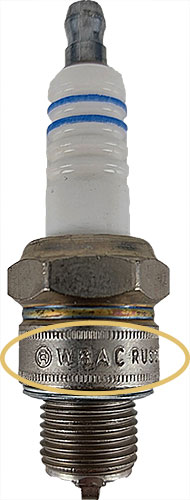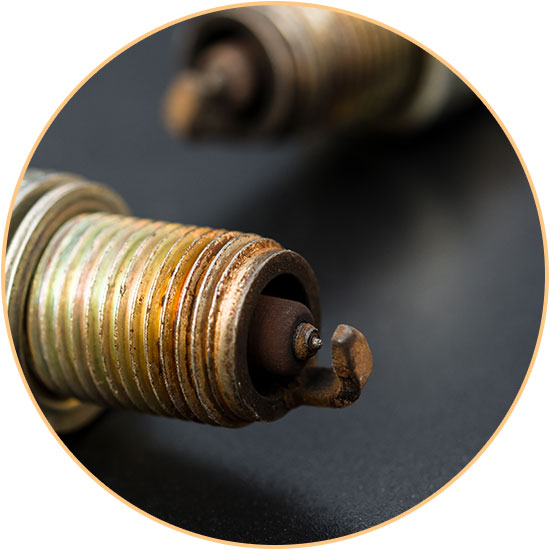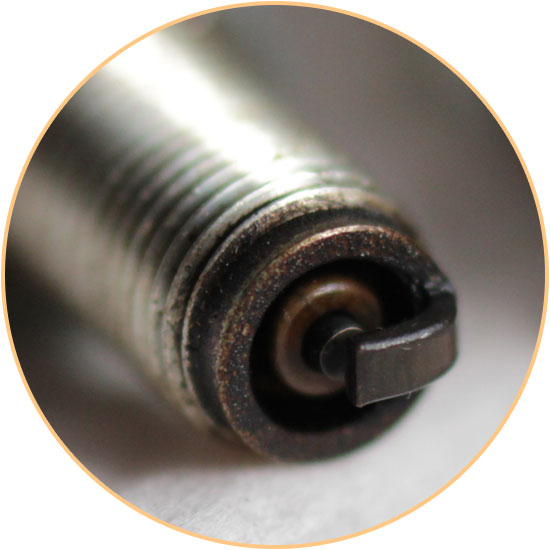Price Match
Now via Live Chat
The way that your old spark plug looks can tell you a lot about what your engine is doing and potentially why it isn’t running correctly.
Wet or dry, black or white, we’ll tell you what you need to do to get your engine running better based on your spark plug condition and how it looks with a visual inspection.
There are four spark plugs on all aircooled VW engines. Two are located each side of the engine, with one per cylinder. The job of a spark plug is to deliver electrical current from the ignition system to the combustion chamber to ignite the fuel/air mixture. The electrical current travels down the centre of the plug to a point on the end where an electrode is mounted onto the end of the plug and the plug is screwed into the cylinder head. Between the point of the plug and the electrode is an air gap. The spark plug is earthed on the outside (when screwed into the cylinder head) and a spark is created every time the current gets to the end of the plug. This spark then ignites the fuel/air mixture and creates combustion.


Cool Air stock two brands of spark plugs, Bosch and NGK. Using the first few letters and numbers on a spark plug we can ascertain what size, length and heat rating it is.
As standard, a VW aircooled engine spark plug has a 14mm thread. However some aftermarket cylinder heads use a 12mm thread. All of our Bosch plugs are 14mm. If you require a 12mm plug then you will need to look at our range of NGK plugs which we stock in both 12mm and 14mm.
The thread of the spark plug is shown by the first letter printed on the side of the plug.
On some of the plugs we stock there is a second letter that follows the first. This letter refers to the design of the spark plug. The most common letters are either ‘P’ which shows the plug has a projected insulator or ‘R’ which means that the plug includes an interference suppression resistor.
The next digit on the spark plug should be a number. This number refers to the heat range that the spark plug works at.
Every spark plug designed has a set heat rating which is a measure of the amount of heat dissipation. This heat rating is indicated by a number which is printed on the side of the spark plug. Numbers range from 2 being the hottest plug to 10 being the coldest plug. But which type is right for you?
Generally lower numbers (hotter plugs) are for use on standard engines and higher numbers (colder plugs) are used on performance engines.
The effect of selecting the wrong heat range can cause damage to the spark plug and cause poor running of your engine. When a heat rating is too high the spark plug temperature remains too low and causes deposits to build up on the end of the plug. As these deposits build up the spark is reduced and eventually will stop sparking all together. However when the heat rating on your spark plug is too low the spark plug temperature rises too high and can cause pre-ignition. This leads to the spark plug electrode melting and can even cause problems such as piston seizure due to the combustion happening while the piston is still travelling up the cylinder towards the head.

After the heat range number you will then see a 3rd letter. This letter shows the thread length of the plug. Generally Type 1 aircooled engines use short reach plugs and Type 4 engines use long reach plugs. But again some aftermarket cylinder heads can change this formula so best to check. Short reach plugs have a thread length of 12.7mm and long reach plugs have a thread length of 19mm.
So now we know the basics of the spark plug we can now remove your plugs from your engine with the correct socket. Access is quite tight to the spark plugs on aircooled VW engines. So it might be worth investing in a spark plug socket with a stumpy ratchet and universal joint to make life a little easier.
In order to access the end of the plug you first need to pull off the HT lead. Make sure when you pull off the HT lead, you hold the bakelite connector and not the lead itself.
If you pull the lead, the chances are you will pull the lead out of the connector.
When you remove your spark plug you should check the end where the spark happens to see if it is dry or wet and what colour it is.

If the firing end of the spark plug is brown or light grey in colour then it means that it is working properly.
Spark plugs that are black in colour suggest that the plug is suffering from carbon deposits on the end of the plug. This can cause starting problems and miss firing of your engine. This can be caused by one of the following reasons:


Spark plugs that are white in colour generally mean that the spark plug is overheating at the point of combustion. This can be caused by one of the following reasons:
If your plugs are wet then this can be because of a number of reasons.

For most aircooled VW engines the plug gap should be 0.024” or 0.6mm but double check in your workshop manual first. To check your gap you will need to use your trusty feeler gauge.
Gaps can be opened up with a flat head screw driver and closed by tapping the end of the plug on a work bench or similar.
The thread on the spark plug is made from steel. The cylinder head you are about to screw the plug into is made from aluminium. This means that the thread on the plug is much harder than the thread in the head. So if you do not screw the plug in correctly then guess what… It’s the head you are going to damage which can become very expensive. So when you screw the spark plug into the head do it by hand. Do not use a socket until the plug is screwed in all the way down. Then once you are happy you can attach your socket to the spark plug and give it a final tighten. By doing it this way you will reduce the risk of cross threading the plug and damaging the thread in the cylinder head. Spark plugs should be torque to 25ftlb.
Once all your plugs are in you can then re-connect your HT leads. It’s ideal to remove one HT lead at a time, remove the plug, re-fit the new plug and then reconnect the HT lead to that plug. Then move onto the next plug and repeat. By doing it this way you shouldn’t get the HT leads mixed up and connected to the wrong plugs.
If however you end up having to fit the HT leads to all the plugs at the same time then you need to connect them in the firing order 1-4-3-2.
Spark plugs should be checked at regular intervals of around 6000 miles. This check should include checking the gaps and cleaning the end of the plug with a brass wire brush. Plugs should be replaced every 12000 miles.